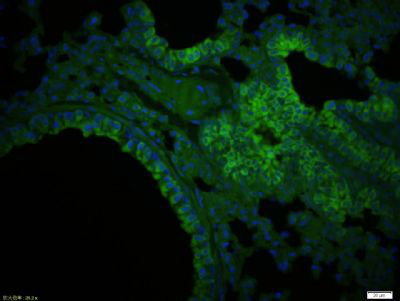产品货号 : mlR11717
英文名称 : CTRP5
中文名称 : 补体C1q和肿瘤坏死因子相关蛋白5抗体
别 名 : C1q and tumor necrosis factor related protein 5; C1QTNF5; Complement C1q tumor necrosis factor related protein 5 precursor; LORD; C1QT5_HUMAN.
研究领域 : 细胞生物 免疫学 神经生物学 细胞粘附分子
抗体来源 : Rabbit
克隆类型 : Polyclonal
交叉反应 : Human, Mouse, Rat, Dog, Pig, Cow, Rabbit,
产品应用 : ELISA=1:500-1000 IHC-P=1:400-800 IHC-F=1:400-800 ICC=1:100-500 IF=1:100-500 (石蜡切片需做抗原修复)
not yet tested in other applications.
optimal dilutions/concentrations should be determined by the end user.
分 子 量 : 24kDa
细胞定位 : 分泌型蛋白
性 状 : Lyophilized or Liquid
浓 度 : 1mg/ml
免 疫 原 : KLH conjugated synthetic peptide derived from human CTRP5:191-243/243
亚 型 : IgG
纯化方法 : affinity purified by Protein A
储 存 液 : 0.01M TBS(pH7.4) with 1% BSA, 0.03% Proclin300 and 50% Glycerol.
保存条件 : Store at -20 °C for one year. Avoid repeated freeze/thaw cycles. The lyophilized antibody is stable at room temperature for at least one month and for greater than a year when kept at -20°C. When reconstituted in sterile pH 7.4 0.01M PBS or diluent of antibody the antibody is stable for at least two weeks at 2-4 °C.
PubMed : PubMed
产品介绍 : Members of the C1q superfamily have diverse functions that are related to cell adhesion and basement membrane components. CTRP5 (Complement C1q tumor necrosis factor-related protein 5) is a 243 amino acid secreted and membrane-associated protein that contains a collagen-like domain and a C1q domain. CTRP5 is a short-chain collagen that is expressed in retinal pigment epithelium as well as brain, lung, liver and placenta. By forming an extracellular hexagonal lattice, CTRP5 facilitates the adhesion of basal retinal pigment epithelium to Bruch’s membrane, the innermost layer of the choroid. A mutation within the C1q domain of CTRP5 results in abnormal high molecular weight aggregate formation, which alters its structure and interactions. This mutation may result in the presentation of late-onset retinal degeneration (LORD), an autosomal dominant disorder that is characterized by punctate yellow-white deposits in the retinal fundus and night blindness.
Function:
Adipose tissue of an organism plays a major role in regulating physiologic and pathologic processes such as metabolism and immunity by producing and secreting a variety of bioactive molecules termed adipokines. One highly conserved family of adipokines is adiponectin/ACRP30 and its structural and functional paralogs, the C1q/tumor necrosis factor-alpha-related proteins (CTRPs) 1-7. Unlike adiponectin, which is expressed exclusively by differentiated adipocytes, the CTRPs are expressed in a wide variety of tissues. These proteins are thought to act mainly on liver and muscle tissue to control glucose and lipid metabolism. An analysis of the crystal structure of adiponectin revealed a structural and evolutionary link between TNF and C1q-containing proteins, suggesting that these proteins arose from a common ancestral innate immunity gene. CTRP5 has been suggested to be involved in age-related macular degeneration.
Subcellular Location:
Secreted
DISEASE:
Defects in C1QTNF5 are a cause of late-onset retinal degeneration (LORD) [MIM:605670]. LORD is an autosomal dominant disorder characterized by onset in the fifth to sixth decade with night blindness and punctate yellow-white deposits in the retinal fundus, progressing to severe central and peripheral degeneration, with choroidal neovascularization and chorioretinal atrophy.
Similarity:
Contains 1 C1q domain.
Contains 1 collagen-like domain.
SWISS:
Q9BXJ0
Gene ID:
114902
Important Note:
This product as supplied is intended for research use only, not for use in human, therapeutic or diagnostic applications.
产品图片












